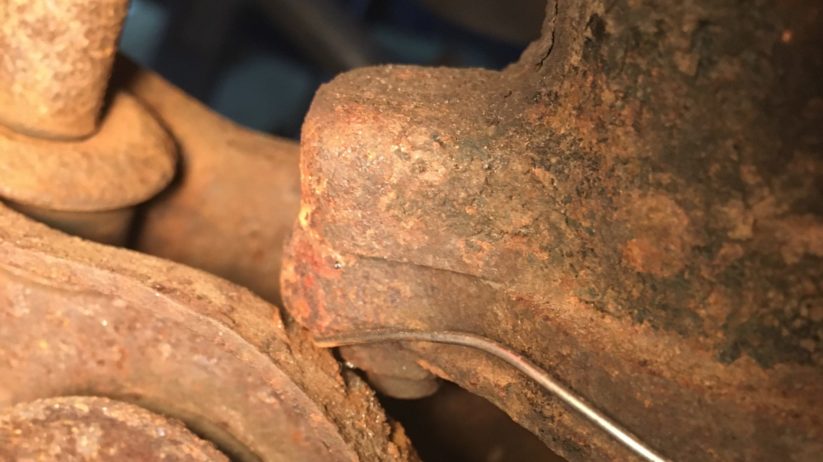After last week’s epic self-indulgent excursion into wheel-swapping (and I must apologize yet again about my dismissive mention of the Kumho Solus tires, because I drove the Kumho-shod Bavaria, tossed it into an entrance ramp, and they didn’t squeal; I don’t know what I was remembering, but I got it wrong), I thought I’d look at something simple and straightforward that I’d, you know, get right.
While I still had Bertha, the transmogrified ’75 2002, here at the house for the wheel swap, I wanted to look at an issue that has bugged me since I resurrected the car and began driving it two years ago. The steering had an odd notchy feel to it while turning left, like how a bearing feels when there’s a divot in the race or a flat spot on the ball. I could crank the steering wheel and push past the notch, relax it, and rock back and forth over the same spot. It was 100% repeatable and particularly disconcerting during aggressive cornering, as there was always the fear in the back of my mind that one day I would turn the wheel and not be able to crank past the notchy spot.
Because it felt like a bad spot in a bearing, it seemed reasonable that the cause was actually in a bearing.
I put the car on the mid-rise lift, turned the steering wheel, and could still feel the notch—that is, it didn’t occur only with the suspension loaded. I laid my hands on the strut-tower bushings while I pushed the wheels lock-to-lock to see if I could isolate the notch to the bearings in the bushings, but I didn’t feel anything there.
The next-most-likely place seemed to be in the steering box. I sighed, because I’d recently given away a good steering box to a friend (he’s done me a number of favors, so no regrets there, just bad timing). I crawled under the car and again moved the wheels lock-to-lock while keeping one hand on the steering box, but when I hit the restriction, I didn’t feel anything in the box. I was relieved, since (A) I didn’t have a spare, and (B) swapping steering boxes is something I wasn’t looking forward to.
I also moved the center track rod back and forth while looking at both the arm coming down from the steering box and the idler arm on the right side, but I didn’t see any physical restriction, like the arms rubbing against something.
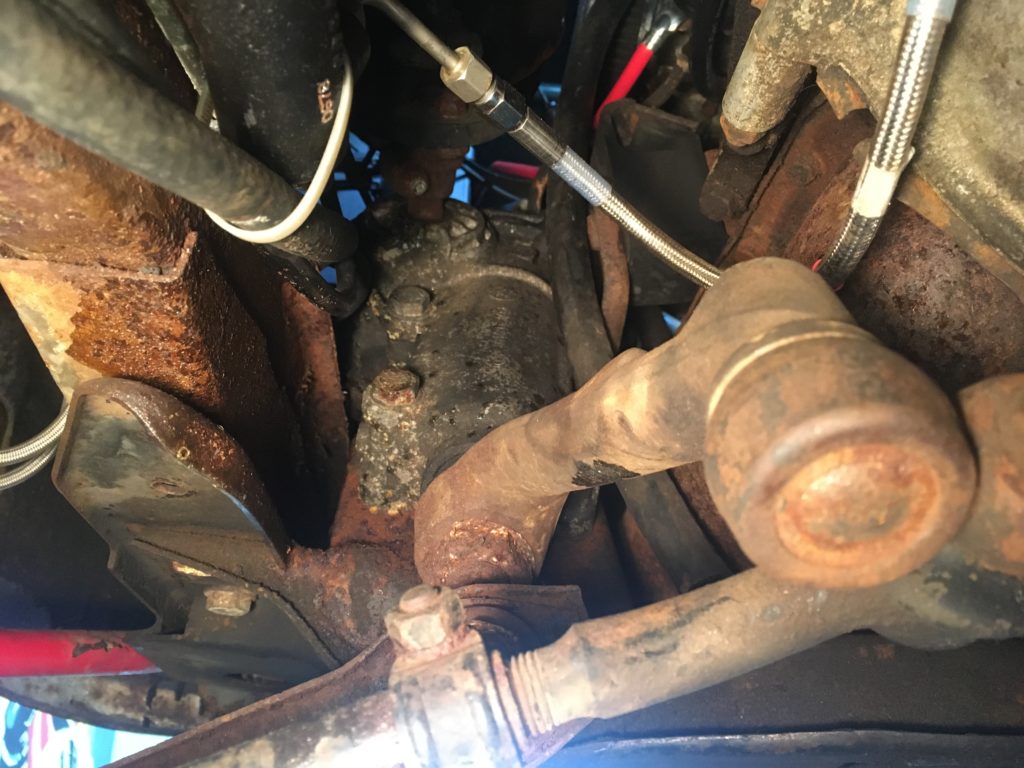
Looking upward at the steering box from under the Pitman arm, or drop arm, as some call it.
When you have a steering issue like this on a 2002, be it binding or a notchy feel like mine, or play, and you can’t figure out where it’s coming from, the thing to do is disconnect components so that you can isolate the cause, whether it is the steering box, the idler-arm bushing, the tie rods, the center track rod, the ball joints, or the shock-tower bearings. I still had a hunch that the problem was in the steering box, so I began to undo the nut securing it to the Pitman arm to disconnect it.
But I’d forgotten how hard it is to get a puller or separator in place at that spot, particularly since I didn’t want to destroy anything.
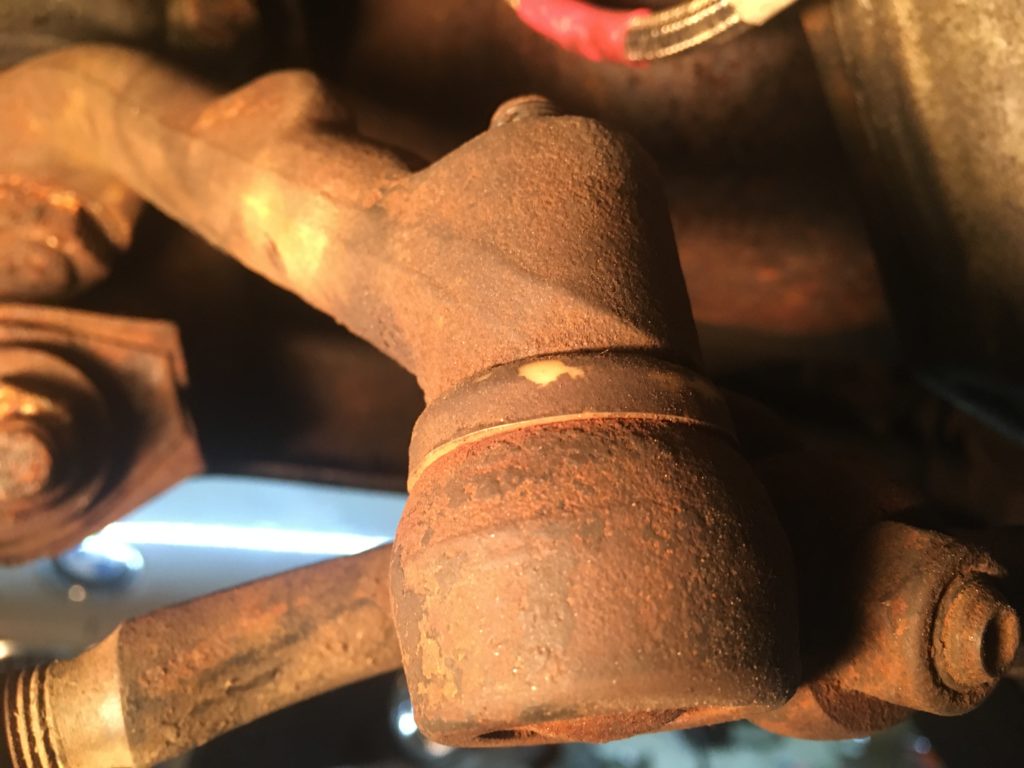
There’s very little room to get a puller on the Pitman arm.
So instead, I removed the nut at the bottom of the left strut assembly that holds the tie rod to the steering knuckle, since there’s plenty of room to get a separator in place there without ripping the rubber boot. This separated the left ball joint and shock-tower bushing/bearing from the rest of the steering.
Before I did the same thing on the right side, as a formality, I grabbed the caliper and rotated the strut assembly, expecting that it would have unimpeded rotation, which would show that the problem was elsewhere in the system. But to my surprise, when I turned it to the left, I found that it had what was clearly a restricted range of motion; it bound up, although I could push through it and keep turning.
The notch: Bingo.
I closely examined the components of the left strut assembly and saw what was clearly the problem: The forward corner of the steering knuckle, and one of the three 14-mm bolts holding it to the bottom of the strut assembly (the ones that the safety wire pass through), were hitting the top front corner of the left control arm.
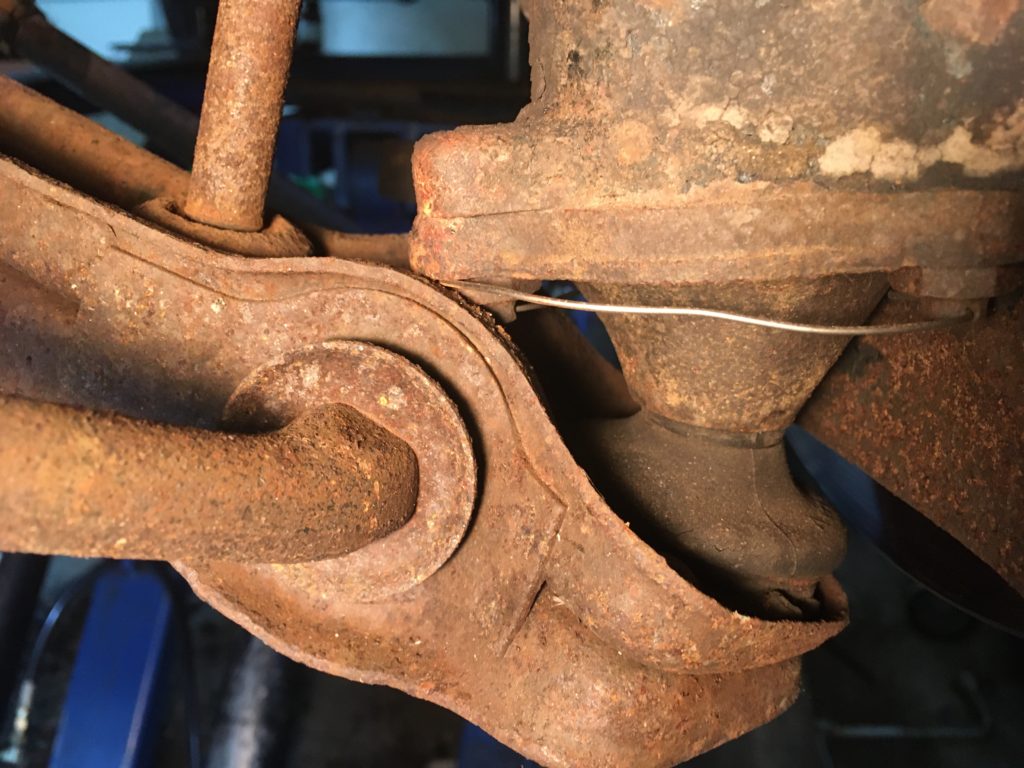
Clearly this interference was the source of the restricted motion.
On closer examination, I could see that three grooves had been worn in the lower control arm from the steering knuckle, the head of the bolt, and the tip.
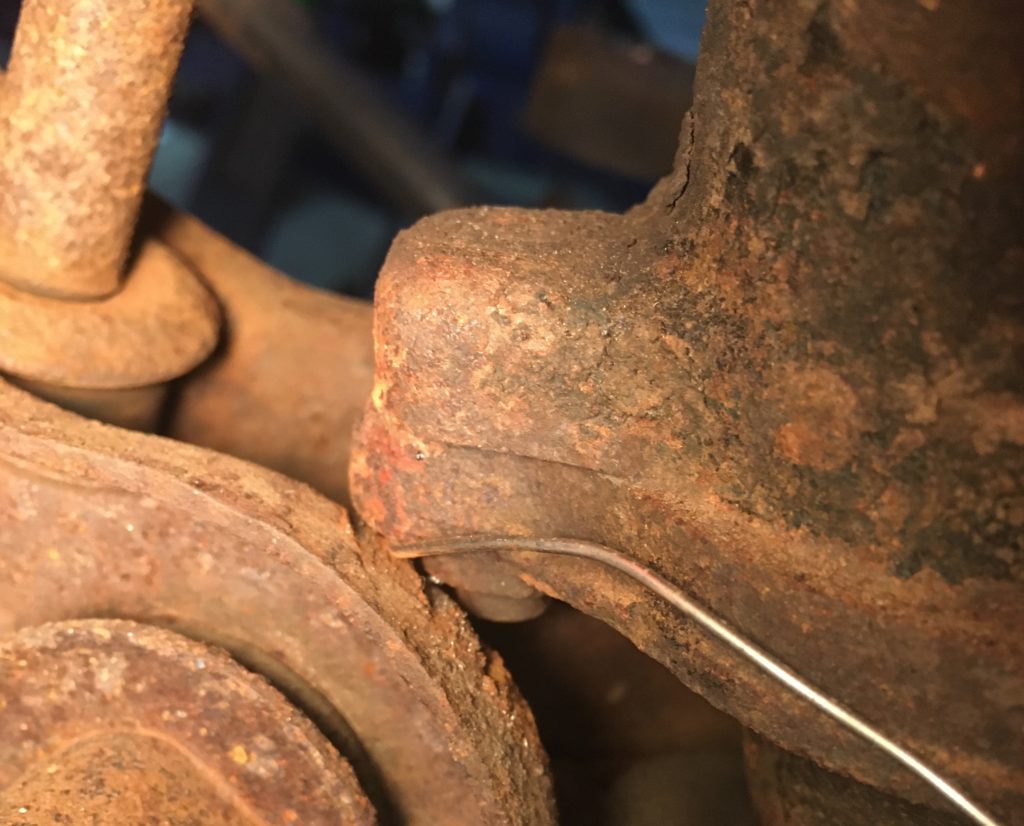
As King Floyd said, groove me.
I looked at the same spot on the right control arm and saw the same thing on both the front and rear corners of the arm, and when I rotated the right strut, I felt the same restriction of movement. It was curious that, while driving, I only felt it while turning left; just to be sure that this was the cause, with both tie rods still disconnected from both steering knuckles, I turned the steering wheel lock-to-lock and didn’t feel any obvious notch or restriction.
While I could’ve just touched up the grooved areas with a Dremel tool to create a skosh more clearance, I wanted to understand the root cause of the problem.
When I resurrected Bertha two years ago and lived under the car for weeks at a time, I was reminded that although the car still had the Koni suspension package (shocks/struts, springs, and sway bars) I’d installed almost 35 years ago, it also was still wearing its original headlight spacers up under the shock towers. These were installed in order to satisfy U.S. DOT headlight height requirements, and made 2002s show a laughable amount of space above the front tires. Most enthusiasts removed them, and they’d certainly be removed if a performance suspension like the Koni package was being fitted. I had a vague memory of leaving them in because I found that there were rubbing or clearance or banging issues with them removed (as I said, a vague memory), but there was no question that the geometry was such that with the spacers installed at the top, they’d essentially add height to the springs, which would cause the bottoms of the struts to be lower, which would tilt the ends of the control arms down, which would cause them to contact the steering knuckles.
Fortunately, removing the spacers is easy; you don’t even need to compress the spring. You just undo the sway-bar end links from the control arms so that the ends of the arms can easily pivot downward, undo the three nuts holding the strut-tower bushings in place, let the strut assemblies sag downward—perhaps helping them with a push at the top and/or bottom—then reach under the fender and lift the spacer off the threaded studs.

Removing that pesky headlight spacer.
When I reattached the components, I could see that there was clearance where there wasn’t clearance before. And more to the point, with the car still on the lift and the wheels in the air, when I rotated the steering wheel, I no longer felt the obvious notchy restriction that I did before.

With the aluminum spacers out, the knuckle was no longer hitting the control arm. The white powder is corrosion that had fallen down from the spacer.
To me, the only question was whether by removing the headlight spacers, I re-created a problem that I’d had 35 years ago. I lowered the car from the lift and took it for a quick drive. I neither felt nor saw any rubbing issues, and the stance in the front didn’t appear artificially low.

The front looks good, doesn’t it?
However, the first time I took a tight left-hand turn onto a side street, I immediately felt that notch in the steering, exactly as it was before.
Really? Seriously?
I pulled the car back into the garage and put it in place on the lift, but before I raised it, I looked at the steering-knuckle-to-control-arm clearance with the car on the ground, which is what I should’ve done before I jumped to conclusions. There was now a massive amount of clearance, like an inch. Seeing this, it seemed clear that the interference and the grooves were just a red herring—it was an artifact of the car being on the lift with the suspension hanging and the control arms drooping down and the spacers still being installed, though I’m a bit unclear exactly how the grooves were formed.
But whatever was causing the notch in the steering that manifested itself while driving, it seemed to have absolutely nothing to do with the grooves in the control arms.

More clearance than needed.
With the car still on the ground, I rotated the steering wheel and felt the notch as clear as day. I then raised it on the lift a little at a time, and as the suspension unloaded, the notch became less and less noticeable. With the wheels in the air, I only found the notch because I was looking for it. It’s likely that this was what happened when I had both tie rods disconnected and rotated the steering lock-to-lock and felt no notch.
So, what’s causing the notch? I still don’t know. I’m back to thinking that it has to be the steering box, or maybe the bearing in the steering column. So much for this being an easy one.—Rob Siegel
Rob’s most recent book, Resurrecting Bertha: Buying Back Our Wedding Car After 26 Years In Storage, is available on Amazon here. His other books, including Just Needs a Recharge: The Hack MechanicTM Guide to Vintage Air Conditioning, are available here on Amazon. Or you can order personally inscribed copies of all of his books through Rob’s website: www.robsiegel.com. His new book, The Lotus Chronicles, will be available in the fall.

